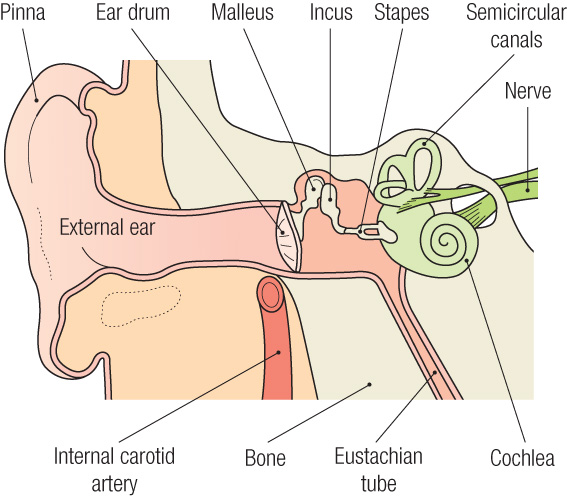EAR CONDITIONS
Painful ears (otalgia) – may be the result of aural disease or referred pain from head or neck. Otitis externaPainful inflammation of the skin that lines the external auditory meatus. Common, often associated with swimming. Acute otitis media (OM)Painful infection (bacterial or viral) of the middle ear. Chronic suppurative OMPersistent drainage from the ear, associated with tympanic membrane perforation and often a degree of conductive hearing loss. Serous/secretory OM (glue ear)Non-suppurative fluid in the middle ear. An important cause of childhood hearing loss.
Ear examination Recommended Procedure. British Society of Audiology (BSA), 2016 Irrigation Normally, earwax is eliminated from the ear canal spontaneously through natural movement of the jaw. However, if wax is retained in the canal it may become impacted. Earwas should be removed if it is totally occluding the ear canal, and:
Initial management includes ear drops for 3–5 days to soften the wax. If symptoms persist, ear irrigation can be considered, providing that there are no contraindications, e.g.
Irrigation should only per performed by an experienced practitioner who has received recognised training in ear care and the use of ear care equipment. Practice Nurse featured article Ear care and irrigation with water: an update Hilary Harkin When not to irrigate and How to irrigate Clinical topic: earwax https://cks.nice.org.uk/earwax
Ear irrigation guideline (2019) Primary Care Ear Centre and Audiology Services HEARING SCREENING All parents in England are offered hearing screening for a new child at 0–5 weeks. Subjective hearing tests in children are not guaranteed to be exact, and the value of screening tests is often questioned. Newborn Hearing Screening https://www.gov.uk/guidance/newborn-hearing-screening-programme-overview Royal National Institution for the Deaf offers support for families https://www.rnid.org.uk HEARING IMPAIRMENTThe biggest single cause of hearing impairment is age. Slight age-related hearing loss (presbycusis) begins in most people at 30–40 years, and by 80 years of age most have significant impairment. Another common cause is loud noise (acoustic trauma). Assessment/detection Adults who think they have a hearing loss should be tested as soon as possible and referred as appropriate to an ENT specialist or audiologist. Some simple tests can be carried out in general practice, but formal audiometry is preferable. Ask ‘Do you have a hearing problem?’ on new-patient questionnaires and during health checks for older people. Presbyacusis. Patient.co.uk Professional reference https://patient.info/doctor/presbyacusis
British Society of Audiology Audiometry Recommended procedures for routine clinical use with adults and children https://www.thebsa.org.uk/resources/ |
|

 Unilateral serous effusion in an adult needs urgent referral.
Unilateral serous effusion in an adult needs urgent referral.